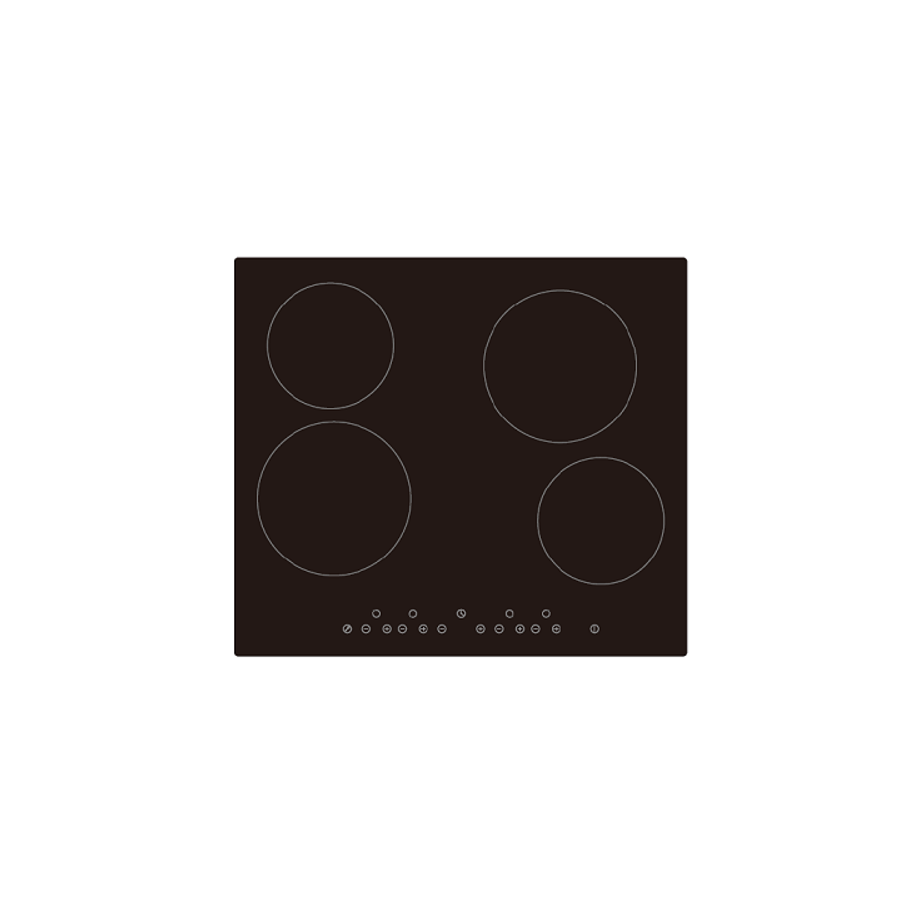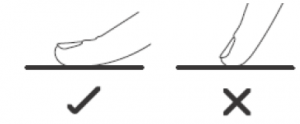kogan Ceramic Cooktop User Guide
Safety & Warnings
Important Safety Instructions
- Read these instructions carefully before installing or using this appliance.
- No combustible material or products should be placed on this appliance at any time due to risk of fire.
- This appliance is to be properly installed and earthed only by a qualified person.
- This appliance should be connected to a circuit which incorporates an isolating switch providing full disconnection from the power supply.
- Failure to install the appliance correctly could invalidate any warranty or liability claims.
- This appliance can be used by children aged 8 years and above and persons with reduced physical, sensory or mental capabilities or lack of experience and knowledge if they have been given supervision or instruction concerning use of the appliance in a safe way and understand the hazards involved.
- Children shall not play with the appliance. Cleaning and user maintenance shall not be performed by children without supervision.
- If the supply cord is damaged, it must be replaced by the manufacturer, its service agent or similarly qualified persons in order to avoid a hazard.
- Warning: If the surface is cracked, switch off the appliance to avoid the possibility of electric shock.
- Metallic objects such as knives, forks, spoons and lids should not be placed on the hob surface, as they can heat up.
- Do not use a steam cleaner to clean your cooktop.
- The appliance is not intended to be operated by means of an external timer or separate remote-control system.
- The cooking process must be supervised. A short-term cooking process must be supervised continuously.
- Warning: Unattended cooking on a hob with fat or oil can be dangerous and may result in fire. Never try to extinguish a fire with water, switch off the appliance and then cover the flame e.g. with a lid or a fire blanket.
- Never leave the appliance unattended when in use. Boil-over causes smoke and greasy spillages that may ignite.
- Never use your appliance as a work or storage surface.
- Never leave any objects or utensils on the appliance.
- Do not place or leave any magnetised objects (e.g. credit cards, memory cards) or electronic devices (e.g. computers, MP3 players) near the appliance, as they may be affected by its electromagnetic field.
- Never use your appliance for warming or heating the room.
- After use, always turn off the cooking zones and the cooktop as described in this manual (i.e. by using the touch controls). Do not rely on the pan detection feature to turn off the cooking zones when you remove the pans.
- Do not allow children to play with the appliance or sit, stand or climb on it.
- Do not store items of interest to children in cabinets above the appliance. Children climbing on the cooktop could be seriously injured.
- Do not leave children alone or unattended in the area where the appliance is in use.
- Children or persons with a disability which limits their ability to use the appliance should have a responsible and competent person to instruct them in its use. The instructor should be satisfied that they can use the appliance without danger to themselves or their surroundings.
- Do not repair or replace any part of the appliance unless specifically recommended in the manual. All other servicing should be done by a qualified technician.
- Do not place or drop heavy objects on your cooktop.
- Do not stand on your cooktop.
- Do not use pans with jagged edges or drag pans across the induction glass surface as this can scratch the glass.
- Do not use scourers or any other harsh abrasive cleaning agents to clean your cooktop, as these can scratch the induction glass.
- This appliance is intended to be used in household/domestic and similar applications such as: staff kitchen areas in shops, offices and other working environments; farmhouses; by clients in hotels, motels and other residential type environments; bed and breakfast environments.
- Warning: The appliance and its accessible parts become hot during use.
- Care should be taken to avoid touching heating elements.
- Children less than 8 years of age should be kept away unless continuously supervised.
Electrical Shock Hazard
- Disconnect the appliance from the mains electricity supply before carrying out any work or maintenance on it.
- Connection to a good earthed wiring system is essential and mandatory.
- Alterations to the domestic wiring system must only be made by a qualified electrician.
- Do not cook on a broken or cracked cooktop. If the cooktop surface is broken or cracked, switch the appliance off immediately at the mains power supply (wall switch) and contact a qualified technician.
- Switch the cooktop off at the wall switch before cleaning or maintenance.
- Failure to follow this advice may result in electrical shock or death.
Cut Hazard
- Take care – panel edges are sharp.
- Failure to use caution could result in injury or cuts.
- The razor-sharp blade of a cooktop scraper is exposed when the safety cover is retracted. Use with extreme care and always store safely and out of reach of children.
Health Hazard
- This appliance complies with electromagnetic safety standards.
- Persons with cardiac pacemakers or other electrical implants (such as insulin pumps) must consult with their doctor or implant manufacturer before using this appliance to make sure that their implants will not be affected by the electromagnetic field.
- Failure to follow this advice may result in death.
Hot Surface Hazard
- During use, accessible parts of this appliance will become hot enough to cause burns.
- Do not let your body, clothing or any item other than suitable cookware contact the induction glass until the surface is cool.
- Keep children away to avoid accidental burns.
- Handles of saucepans may be hot to touch. Check saucepan handles do not overhang other cooking zones that are on. Keep handles out of reach of children.
- Failure to follow this advice could result in burns and scalds.
Overview
Top View
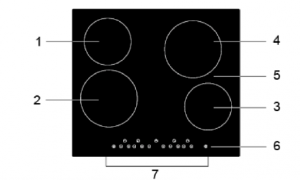
| 1 | Maximum 1200W zone |
| 2 | Maximum 1800W zone |
| 3 | Maximum 1200W zone |
| 4 | Maximum 1800W zone |
| 5 | Glass plate |
| 6 | ON/OFF |
| 7 | Control panel |
Control Panel

| 1 | ON/OFF control |
| 2 | Power regulating controls |
| 3 | Key lock control |
| 4 | Timer regulating controls |
Installation
Selection of Installation EquipmentFor the purpose of installation and use, a minimum of 5cm space shall be preserved around the hole. Be sure the thickness of the work surface is at least 30mm. Please select heat-resistant and insulated work surface material (Wood and similar fibrous or hygroscopic material should not be used as work surface material) to avoid the electrical shock and larger deformation caused by the heat radiation from the hotplate.
 Note: The safety distance between the sides of the hob and the inner surfaces of the worktop should be at least 3mm.
Note: The safety distance between the sides of the hob and the inner surfaces of the worktop should be at least 3mm.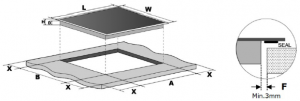
| L(mm) | W(mm) | W(mm) | D(mm) | A(mm) | B(mm) | X(mm) | F(mm) |
| 590 | 520 | 55 | 51 | 560+4
+1 |
490+4
+1 |
50 (min) | 3 (min) |
Under any circumstances, make sure the ceramic cooker hob is well ventilated and the air inlet and outlet are not blocked. Ensure the ceramic cooker hob is in good working state. As shown below
 Note: The safety distance between the hotplate and the cupboard above the hotplate should be at least 760mm.
Note: The safety distance between the hotplate and the cupboard above the hotplate should be at least 760mm.
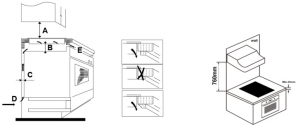
| A(mm) | B(mm) | C(mm) | D | E |
| 760 | 50 (min) | 20 (min) | Air intake | Air exit 5mm |
Warning: Ensuring adequate ventilation.
Make sure the ceramic hob is well ventilated and the air inlet and outlet are not blocked. In order to avoid accidental touch with the overheating bottom of the hob or getting unexpected electric shock during working, it is necessary to put a wooden insert, fixed by screws, at a minimum distance of 50mm from the bottom of the hob. Follow the requirements below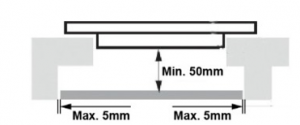
 There are ventilation holes around the outside of the hob. You must ensure that these holes are not blocked by the worktop when you put the hob into position.
There are ventilation holes around the outside of the hob. You must ensure that these holes are not blocked by the worktop when you put the hob into position.
- Be aware that the glue that joins the plastic or wooden material to the cooktop must resist temperatures up to 150°C.
- The rear wall, adjacent and surrounding surfaces must therefore be able to withstand a temperature of 90°C.
Before Locating the Fixing Brackets
The unit should be placed on a stable, smooth surface (use the packaging). Do not apply force onto the controls protruding from the hob.Fix the hob on the work surface by screw four brackets on the bottom of hob (see picture below) after installation.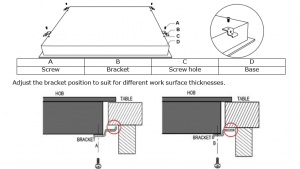
 Under any circumstances, the brackets cannot touch the inner surfaces of the worktop after installation
Under any circumstances, the brackets cannot touch the inner surfaces of the worktop after installation
Cautions:
- The ceramic cooktop must be installed by qualified personnel or technicians. Please never conduct the installation by yourself.
- The ceramic cooktop shall not be mounted to cooling equipment, dishwashers and rotary dryers.
- The ceramic cooktop shall be installed such that better heat radiation can be ensured to enhance its reliability.
- The wall and induced heating zone above the work surface should withstand heat.
- To avoid any damage, the adhesive must be resistant to heat.
- A steam cleaner is not to be used.
Connecting the Hob to the Mains Power Supply
The power supply should be connected in compliance with the relevant standard or a single-pole circuit breaker. The method of connection is shown below.
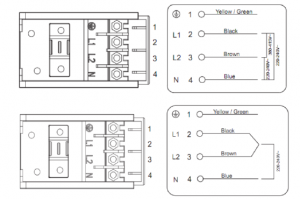
- If the cable is damaged or needs replacement, this should be done by a qualified technician using the proper tools, to avoid any accidents.
- If the appliance is being connected directly to the mains supply, an omnipolar circuit breaker must be installed with a minimum gap of 3mm between the contacts.
- The installer must ensure that the correct electrical connection has been made and that it complies with safety regulations.
- The cable must not be bent or compressed.
- The cable must be checked regularly and only replaced by a properly qualified person.
 The bottom surface and the power cord of the hob are not accessible after installation.
The bottom surface and the power cord of the hob are not accessible after installation.
Operation
Before Using your New Ceramic Hob
- Read this guide, taking special note of the ‘Safety Warnings’ section.
- Remove any protective film that may still be on your ceramic hob.
Touch Controls
- The controls respond to touch, so you don’t need to apply any pressure.
- Use the ball of your finger, not its tip.
- You will hear a beep each time a touch is registered.
- Make sure the controls are always clean, dry and that there is no object (e.g. a utensil or a cloth) covering them. Even a thin film of water may make the controls difficult to operate.

Choosing the Right Cookware
- Do not use cookware with jagged edges or a curved base.

- Make sure that the base of your pan is smooth, sits flat against the glass and is the same size as the cooking zone. Always centre your pan on the cooking zone.

- Always lift pans off the ceramic hob. Do not slide or they may scratch the glass.
Start Cooking
After powering on, the buzzer beeps once, all the indicators light up for 1 second then go out, indicating that the cooktop has entered the state of standby mode.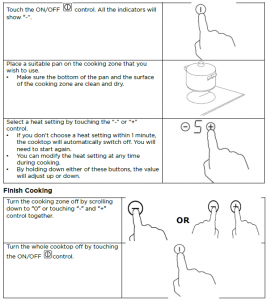
Beware of hot surfaces:
“H” will show which cooking zone is hot to touch. It will disappear when the surface has cooled down to a safe temperature. It can also be used as an energy saving function if you want to heat further pans, use the hotplate that is still hot.

Locking the Controls
- You can lock the controls to prevent unintended use. (for example, to prevent children accidentally turning the cooking zones on)
- When the controls are locked, all the controls except the ON/OFF control are disabled.
| To lock the controls | |
|
Touch the lock |
The timer indicator will show “Lo” |
| To unlock the controls | |
| Make sure the ceramic hob is turned on
Touch and hold the lock |
you can always turn the ceramic hob off with the ON/OFF control in an emergency, but you should unlock the hob first in the next operation
Timer Control
You can use the timer in two different ways:a) You can use it as a minute minder. In this case, the timer will not turn any cooking zone off when the set time is up.b) You can set it to turn one or more cooking zones off after the set time is up.
- The maximum limit of the timer is 99 minutes. Timer overview

a) Using the timer as a minute minder:
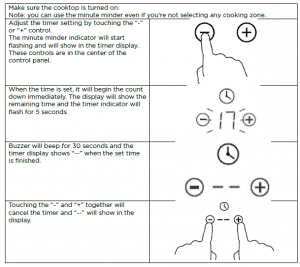
- Touch the “-” or “+” control of the timer once to decrease or increase by 1 minute.
- Touch and hold the “-” or “+” control of the timer to decrease or increase by 10 minutes.
- If the setting time exceeds 99 minutes, the timer will automatically return to 0 minutes.
b) Setting the timer to turn one or more cooking zones off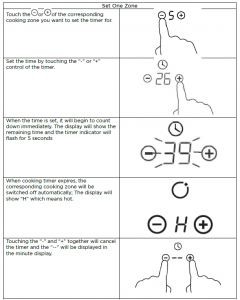
Note:a) The red dot next to power level indicator will illuminate indicating that zone is selected.
b) If you want to change the time after the timer is set, you must start from step 1. Setting the timer to turn more than one cooking zones offa) If more than one heating zones use this function, the timer indicator will show the lowest time. (e.g. zone 1# setting time of 5 minutes, zone 2# setting time of 15 minutes, the timer indicator shows “5”)Note: The red dot next to power level indicator will flash.
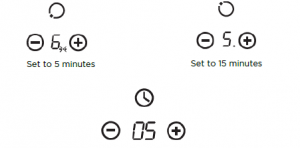
b) Once the countdown timer expires, the corresponding zone will switch off. Then it will show the new lowest time and the dot of corresponding zone will flash.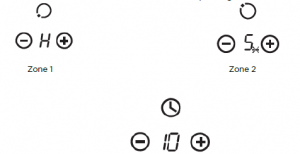
c) When cooking timer expires, the corresponding cooking zone will switch off automatically.
Note:1) The red dot next to power level indicator will illuminate indicating that zone is selected.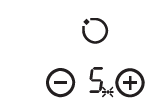
2) If you want to change the time after the timer is set, you must start from step 1.
Over-Temperature Protection
A temperature sensor is used to monitor the temperature inside the cooktop. When an excessive temperature is monitored, the cooktop will stop operation automatically.
Residual Heat Warning
When the cooktop has been operating for some time, there will be some residual heat. The letter “H” appears to warn you to keep away from it.
Default Working Times
Another safety feature of the cooktop is automatic shutdown. This occurs whenever you forget to switch off a cooking zone. The default shutdown times are shown in the table below:
| Power level | 1 | 2 | 3 | 4 | 5 | 6 | 7 | 8 | 9 |
| Default working timer (hour) | 8 | 8 | 8 | 4 | 4 | 4 | 2 | 2 | 2 |
Cooking Guidelines
Take care when frying as oil and fat heat up very quickly, particularly if you’re using Power Boost. At extremely high temperatures, oil and fat will ignite spontaneously and this presents a serious fire risk.
Cooking tips:
- When food comes to the boil, reduce the temperature setting.
- Using a lid will reduce cooking times and save energy by retaining the heat.
- Minimise the amount of liquid or fat to reduce cooking times.
- Start cooking on a high setting and reduce the setting when the food has heated thoroughly.
Simmering, cooking rice:
- Simmering occurs below boiling point, at around 85°C, when bubbles are just rising occasionally to the surface of the cooking liquid. It is the key to delicious soups and tender stews because the flavours develop without overcooking the food. You should also cook egg-based and flour thickened sauces below boiling point.
- Some tasks, including cooking rice by the absorption method, may require a setting higher than the lowest setting to ensure the food is cooked properly in the time recommended.
Searing steak:To cook juicy flavoursome steaks
- Stand the meat at room temperature for about 20 minutes before cooking.
- Heat up a heavy-based frying pan.
- Brush both sides of the steak with oil. Drizzle a small amount of oil into the hot pan and then lower the meat onto the hot pan.
- Turn the steak only once during cooking. The exact cooking time will depend on the thickness of the steak and how cooked you want it. Times may vary from about 2 – 8 minutes per side. Press the steak to gauge how cooked it is. The firmer it feels the more ‘well done’ it will be.
- Leave the steak to rest on a warm plate for a few minutes to allow it to relax and become tender before serving.
For stir-frying:
- Choose a ceramic compatible flat-based wok or a large frying pan.
- Have all the ingredients and equipment ready. Stir-frying should be quick. If cooking large quantities, cook the food in several smaller batches.
- Preheat the pan briefly and add two tablespoons of oil.
- Cook any meat first, put it aside and keep warm.
- Stir-fry the vegetables. When they are hot but still crisp, turn the cooking zone to a lower setting, return the meat to the pan and add your sauce.
- Stir the ingredients gently to make sure they are heated thoroughly.
- Serve immediately.
Heat Settings
The settings below are guidelines only. The exact setting will depend on several factors, including your cookware and the amount you are cooking. Experiment with the cooktop to find the settings that best suit you.
| Heat settings | Suitability |
| 1-2 | • delicate warming for small amounts of food
• melting chocolate, butter and foods that burn quickly • gentle simmering • slow warming |
| 3-4 | • reheating
• rapid simmering • cooking rice |
| 5-6 | • pancakes |
| 7-8 | • sautéing
• cooking pasta |
| 9 | • stir-frying
• searing • bringing soup to the boil • boiling water |
Cleaning & Care
| What? | How? | Important! |
| Everyday dirt on glass (fingerprints, marks, stains left by food or non-sugary spillages on the glass) | 1. Switch the power to the cooktop off.
2. Apply a cooktop cleaner while the glass is still warm (but not hot!) 3. Rinse and wipe dry with a clean cloth or paper towel. 4. Switch the power to the cooktop back on. |
• When the power to the cooktop is switched off, there will be no ‘hot surface’
indication but the cooking zone may still be hot! Take extreme care. • Heavy-duty scourers, some nylon scourers and harsh/abrasive cleaning agents may scratch the glass. Always read the label to check if your cleaner or scourers is suitable. • Never leave cleaning residue on the cooktop, the glass may become stained. |
| Boil-over, melted and hot sugary spills on the glass | Remove these immediately with a fish slicer, palette knife or razor blade scraper suitable for Ceramic glass cooktops, but beware of hot cooking zone surfaces:
1. Switch the power to the cooktop off at the wall. 2. Hold the blade or utensil at a 30° angle and scrape the dirt or spill on a cool area of the cooktop. 3. Clean the dirt or spill with a dish cloth or paper towel. 4. Follow steps 2 to 4 for ‘Everyday dirt on glass’ above. |
• Remove stains left by melted and sugary food or spillages as soon as
possible. If left to cool on the glass, they may be difficult to remove or even permanently damage the glass surface. • Cut hazard: when the safety cover is retracted, the blade in a scraper is razor-sharp. Use with extreme care and always store safely and out of reach of children. |
| Spillages on the touch controls | 1. Switch the power to the cooktop off.
2. Soak up the spill. 3. Wipe the touch control area with a clean damp sponge or cloth. 4. Wipe the area completely dry with a paper towel. 5. Switch the power to the cooktop back on. |
• The cooktop may beep and turn itself off and the touch controls may not function
while there is liquid on them. Make sure you wipe the touch control area dry before turning the cooktop back on. |
Specifications
| Cooking zones | 4 Zones |
| Supply voltage | ~220-240V, 50Hz or 60Hz |
| Installed electric power | 5500-6600W |
| Product size DxWxH (mm) | 590x520x55 |
| Building-in Dimensions AxB (mm) | 560×490 |
Troubleshooting
| Problem | Possible causes | What to do |
| The cooktop cannot be turned on. | No power. | Make sure the cooktop is connected to the power supply and that it is switched on.
Check whether there is a power outage in your home or area. If you’ve checked everything and the problem persists, call a qualified technician. |
| The touch controls are unresponsive. | The controls are locked. | Unlock the controls. See section “Locking the
Controls” for instructions. |
| The touch controls are difficult to operate. | There may be a slight film of water over the controls or you may be using the tip of your finger when touching the controls. | Make sure the touch control area is dry and use the ball of your finger when touching the controls. |
| The glass is being scratched. | Rough-edged cookware. Unsuitable, abrasive scourers or cleaning products being used. | Use cookware with flat and smooth bases. See ‘Choosing the right cookware’.
See ‘cleaning and care’. |
| Some pans make crackling or clicking noises. | This may be caused by the construction of your cookware. (layers of different metals vibrating
differently) |
This is normal for cookware and does not indicate a fault. |
Disposal
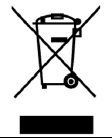 This marking indicates that this appliance should not be disposed with other house-hold wastes. To prevent possible harm to the environment or human health from uncontrolled waste disposal, recycle it responsibly to promote the sustainable reuse of material resources.User manual is subject to change without notice. For the latest version of your user manual, please visit https://www.kogan.com/usermanuals/
This marking indicates that this appliance should not be disposed with other house-hold wastes. To prevent possible harm to the environment or human health from uncontrolled waste disposal, recycle it responsibly to promote the sustainable reuse of material resources.User manual is subject to change without notice. For the latest version of your user manual, please visit https://www.kogan.com/usermanuals/
Read More About This Manual & Download PDF:
[xyz-ips snippet=”download-snippet”]

